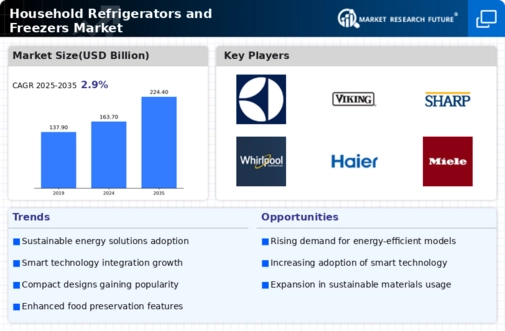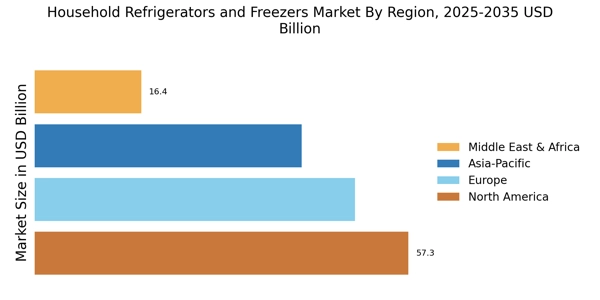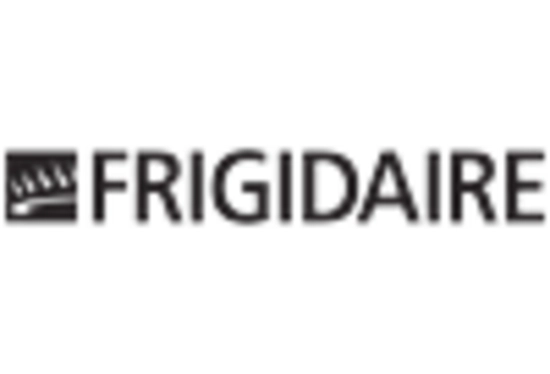Sustainability Focus
The increasing emphasis on sustainability appears to be a pivotal driver in the Household Refrigerators and Freezers Market. Consumers are becoming more environmentally conscious, leading to a demand for energy-efficient appliances. According to recent data, energy-efficient refrigerators can reduce energy consumption by up to 50%, which not only lowers utility bills but also minimizes carbon footprints. Manufacturers are responding by developing models that utilize eco-friendly refrigerants and materials. This trend is likely to continue as regulations around energy efficiency tighten, compelling companies to innovate. The shift towards sustainable practices may also enhance brand loyalty, as consumers prefer companies that align with their values. Thus, the sustainability focus is not merely a trend but a fundamental shift in consumer behavior that is reshaping the Household Refrigerators and Freezers Market.
Rising Disposable Income
Rising disposable income levels are playing a crucial role in shaping the Household Refrigerators and Freezers Market. As consumers experience increased financial flexibility, they are more inclined to invest in high-quality, advanced refrigeration solutions. This trend is particularly evident in emerging markets, where economic growth is leading to a burgeoning middle class. Market analysis indicates that households with higher disposable incomes are more likely to purchase premium appliances that offer enhanced features and energy efficiency. This shift in consumer spending patterns is prompting manufacturers to focus on producing high-end models that cater to this demographic. Consequently, the rising disposable income is likely to drive growth in the Household Refrigerators and Freezers Market, as consumers seek appliances that provide both functionality and luxury.
Health and Wellness Trends
The increasing focus on health and wellness is significantly influencing the Household Refrigerators and Freezers Market. Consumers are becoming more health-conscious, leading to a demand for appliances that support healthier lifestyles. Refrigerators with features such as built-in water filtration systems, humidity control for fresh produce, and compartments designed for specific food types are gaining popularity. Market data suggests that the health and wellness segment is expected to grow, with consumers willing to invest in appliances that promote better food storage and preservation. This trend is likely to drive innovation, as manufacturers seek to incorporate health-oriented features into their products. As the connection between food storage and health becomes more pronounced, the Household Refrigerators and Freezers Market may see a shift towards appliances that align with these wellness trends.
Smart Technology Integration
The integration of smart technology into household appliances is transforming the Household Refrigerators and Freezers Market. Smart refrigerators equipped with Wi-Fi connectivity, touch screens, and inventory management systems are gaining traction among tech-savvy consumers. These features allow users to monitor food inventory, receive alerts for expiration dates, and even create shopping lists remotely. Market data indicates that the smart appliance segment is expected to grow significantly, with projections suggesting a compound annual growth rate of over 20% in the coming years. This trend reflects a broader shift towards home automation, where convenience and efficiency are paramount. As consumers increasingly seek appliances that enhance their lifestyle, the demand for smart refrigerators and freezers is likely to rise, further driving innovation in the Household Refrigerators and Freezers Market.
Customization and Versatility
Customization and versatility are emerging as key drivers in the Household Refrigerators and Freezers Market. Consumers are increasingly looking for appliances that cater to their specific needs and preferences. This trend is evident in the growing popularity of modular refrigerators that allow users to adjust configurations based on their kitchen space and storage requirements. Market Research Future indicates that nearly 30% of consumers prioritize customizable features when selecting a refrigerator. Additionally, the rise of multi-functional appliances that combine refrigeration and freezing capabilities is appealing to those with limited kitchen space. This demand for tailored solutions is prompting manufacturers to innovate and offer a wider range of options, thereby enhancing consumer satisfaction. As the market evolves, the emphasis on customization and versatility is likely to shape the future landscape of the Household Refrigerators and Freezers Market.


















Leave a Comment